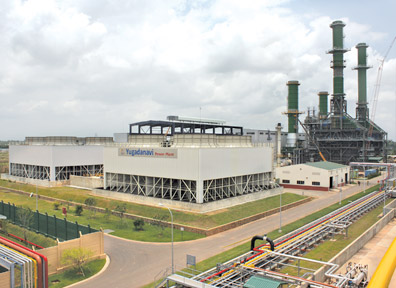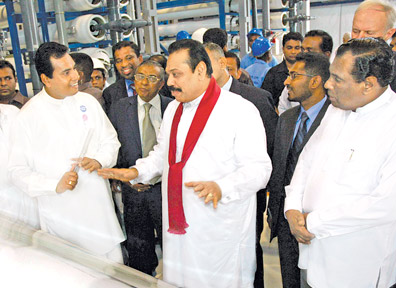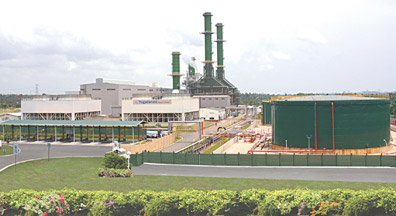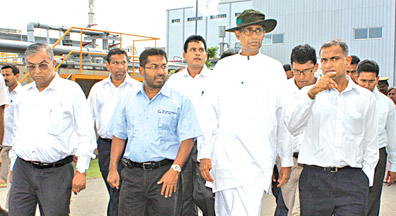|
Sri Lanka's goal:
Self-sufficiency in power by 2011
By Shirajiv SIRIMANE
 |
|

President Mahinda Rajapaksa commissioning the Yugadanavi
Combined Cycle Power Plant at Kerawalapitiya |
Sri Lanka was a nation which was notorious for having Asia's highest
electricity tariff. However, it's ready to break out of this cycle and
what's more be in a position to even export electricity in less than two
years. The country's Public, which is used to paying 'extra' for
everything, will soon find that they would be paying less for
electricity.
The secret is the commissioning of mega power generation projects
which had been on hold for decades. Kotmale, Sampur and Norochcholai are
some of these projects which are now nearing completion. In addition to
the controversies these projects had generated, funds too had been a
grey area and today they too have been sorted out.
The Kerawalapitiya power generation project was first planned in
1990, but was kept on hold for nearly a decade until a decision was
taken three years ago to fast-track this project.
International tenders were called for and since they were expensive
it was decided to award the construction of the Kerawalapitiya
power-generation project to a consortium of local engineers. It was to
be constructed as a government/private sector joint venture.
The local consortium first decided to do away with the use of diesel
and decided on using heavy furnace oil, which is 60 percent cheaper than
diesel thus making the project more viable.
The contract was awarded to Lanka Transformers Ltd. (LTL), a
subsidiary of Ceylon Electricity Board. Thirty percent of the funding
came from the Government via National Savings Bank, EPF, LECO and LTL.
The total cost of the project was Rs. 3.4 billion and 70 percent of this
was borrowed from international parties.
In less than two years, the first phase was completed, adding 200
Mega Watts to the national Grid. The second stage too was commissioned,
to add 100 MW, early this year. Of the 300 MW of power, 200MW are
generated using furnace oil and the balance 100MW are generated using
steam emanated from the plant. Conserving the environment was one of the
priorities of the engineers and several meaningful steps were taken in
this regard. The kiln which disperses the smoke was built to a height of
80 metres minimising the impact on the environment. Chief Operating
Officer (COO) of the project, Nuhuman Marikkar said that the Central
Environmental Authority has endorsed that the emission level of the
project is lower than what is expected.
Local engineers
The local engineers also decided to use sea water for cooling which
is considered to be one of the unique features of the project. A special
process was introduced for desalination and local engineers have also
ensured that the water which goes back to the sea is not too warm to
upset the sea's ecological pattern in the area. "Introduction of sea
water for cooling for a plant of this nature is a first for the region,"
he said.
The commissioning of this plant will considerably reduce the
country's dependence on diesel for generation of power. The steam which
will be a byproduct from the first phase operation of the plant will
have no bearing on the production expenses.
Marikkar says that the project can be in operation for nearly 50
years. This is an investment made towards economic development at the
right time, he said.
 |
 |
|
Minister of Power and
Energy Patali Champika Ranawaka visiting the site. The
Kerawalapitiya power-generation site |
He said the building of these plans would help the country do away
with power interruptions in the future, a feat even other countries in
the region could not carry out. In addition, since the cost of power
generation is less than for diesel, the public is assured that there
would be no high electricity tariff in the future.
"The more the country moves away from diesel power generation, which
is now at 18 percent, the bill the customers pay would be less," he
said.
Currently, furnace oil is transported to the project in bowsers.
Construction is now under way to lay a pipeline from the deep sea, four
kilometres out of the Kerawalapitiya plant, so that ships could unload
furnes oil direct to the plant.
"This, on the long run, would be a saving on transport and labour,"
he said.
This pipeline is expected to be ready by the end of January. Today 40
percent of electricity is generated via hydro power and 18 percent is
from diesel power, which costs the country Rs. 18 per unit.
The Kerawalapitiya power plant is currently in a position to
manufacture a unit of electricity for less than Rs. 16.
Selling power to Tamil Nadu
Coal power generation costs around Rs. 10 per unit. Unfortunately,
only 10 percent of the requirement will be generated this way via the
plant in Sampur.
The project will generate 500MW in the first phase and another 500MW
under the second phase.
The project will be a joint venture with India and was delayed due to
disputes over the site location. The Rs. 5 billion project will see the
Asian Development Bank providing US $ 350 million under a 40-year loan
while Sri Lanka and India will both invest US$ 75 million each.
Tamil Nadu is the 11th largest State in India by area (about the size
of Greece) and the seventh most populous State.
It is the fifth largest contributor to India's economy and the most
urbanised State in India. The State has the highest number (10.56
percent) of business enterprises in India, compared to the population
share of about six percent. Tamil Nadu is severely affected by power
shortages.
Under-sea power line
One of the unique and historic features of this project is its plan
to sell Sri Lankan electricity to India. Planning is now being done to
lay under-sea transmission lines from Anuradhapura to Talaimannar and
from Talaimannar to Rameswaram (India). This would be a 45km stretch.
The Board of Investment has granted approval to an Indian investor to
invest US$ 18.55 million to build a 10 mega watt wind power plant in
north-western Sri Lanka. The project is expected to commence operations
by June 2011.
The private sector is also being encouraged to set up small-scale
power projects using renewable energy technologies to minimise the
dependence on oil and gas.
With these development projects in the pipeline Sri Lanka is planning
to make the country self-sufficient in power, within the next 10 months
although it was earlier targeted for 2012. |

